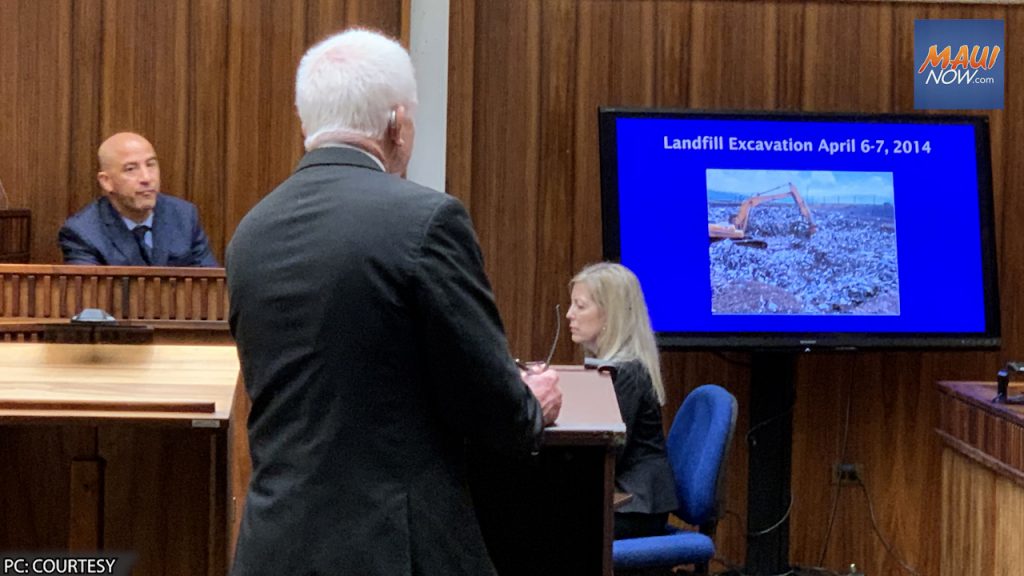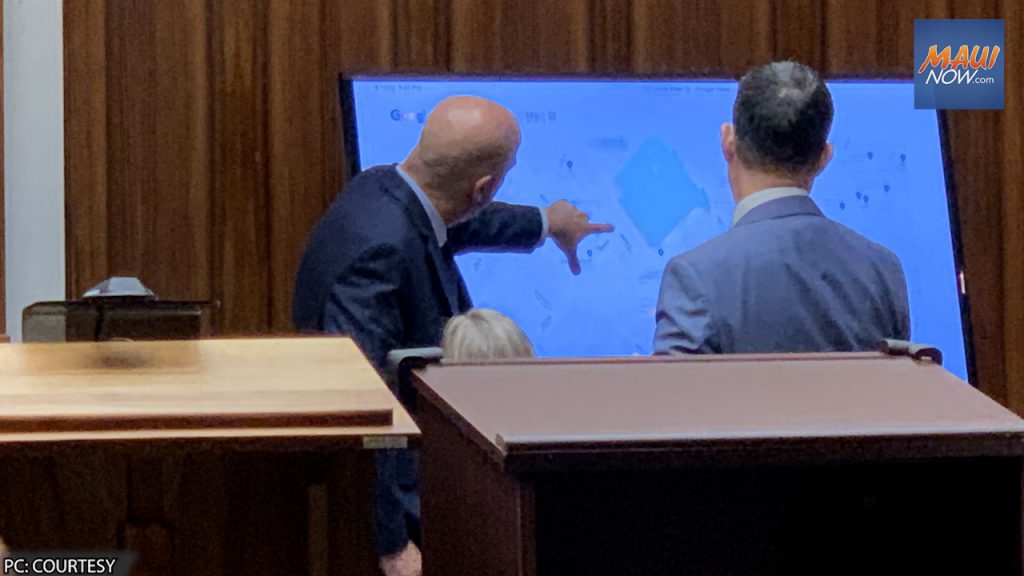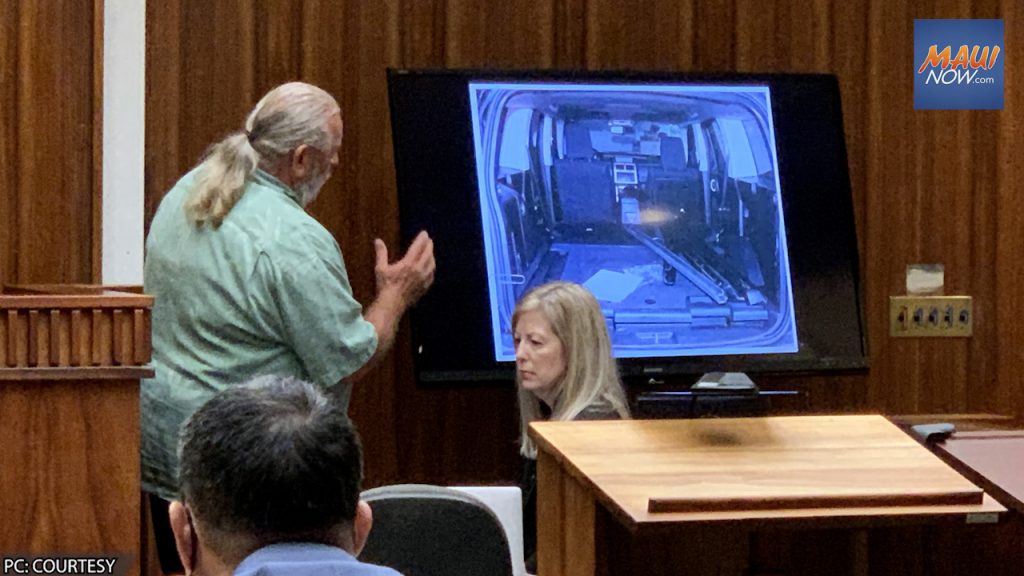Maui murder trial: Series of searches included use of cadaver dogs and landfill excavation

The Maui Police Department detective heading the missing person investigation into the disappearance of Moreira “Mo” Monsalve, said exhaustive searches were conducted at 15 sites over a more than five year period. Many of the searches involved the use of cadaver dogs, and one search in particular utilized heavy equipment for the excavation of the Central Maui Landfill.
Detective Oran Satterfield said that in addition to the searches, police also conducted electronic evidence gathering, interviewed numerous people, and contacted airlines, but authorities were unable to find Monsalve.
Thursday marked Day 6 of a trial for Bernard Brown, who is accused of second degree murder in the disappearance and presumed death of Monsalve, who was his ex-girlfriend at the time. The 46-year-old mother of three was last seen on the evening of Sunday, Jan. 12, 2014, more than eight years ago. Brown has pleaded not guilty to the charges.
Det. Satterfield became the lead investigator on the case a week after Monsalve was reported missing. He outlined the areas and dates searched over the course of the investigation.
- Waipoli Rd. in Kula, Jan. 18 2014. Two cadaver dogs from the State of Hawaiʻi Civil Defense agency assisted in looking for human remains. The team searched one side of the road way and used gps to track their progress of areas covered.
- Waipoli Rd. in Kula, Jan. 24-25, 2014. Police returned to the area with two cadaver dogs to search the opposite (east side) of the roadway.
- Kahekili Highway, Jan. 24-25, 2014. Police crews searched both sides of highway.
- Central Maui Landfill, Jan. 24-25, 2014. The department used gps coordinates to track the area where trash was collected and dumped during the week of Jan. 12. They marked the location of the area to be excavated, and did a surface search using a cadaver dog.
- Central Maui Landfill excavation, April 6-7, 2014: Police went back to same area and excavated 2,200 tons of garbage.
- Piʻihana Rd., Aug. 18, 2014: Police did a canine search with cadaver dogs. Police searched the area in relation to the defendant’s residence. This is up the street from the defendant’s residence, right behind Maui Disposal.
- Kahekili Highway, Aug. 18 2014: Police searched in a different location, past Mendez Ranch. Police say there was no tip that led them to the area, but just decided to search there.
- Waiehu Golf Course, Aug. 18, 2014.
- Waiheʻe River, Sep. 9, 2015: Police say there was no tip for this location, but they decided to search there because it had not been covered yet. Police asked Civil Defense if cadaver dogs could still track remains after such a long period, and the response was “yes,” according to Det. Satterfield.
- Camp Maluhia, Sep. 9, 2015
- Y Hata waterfront, sep. 9, 2015
- Makamakaʻole Gulch, Sept 10 2015. There were no tips for this location.
- Keōpūolani Park, Feb. 14, 2019: Police say they went through entire park searching for human remains.
- Kanahā Beach Park, Feb. 15 2019: In a similar way, police did a search looking for human remains. Police inquired and were told that cadaver dogs could still identify skeletal remains after several years.
- Halekiʻi-Pihana Heiau, April 8, 2019: This is located right next to a reservoir, and within a few minutes of the defendant’s residence at ʻĪao Parkside.

When a juror asked why some of the searches were not initiated for over 7 months, Det. Satterfield pointed toward lack of resources, scheduling conflicts, and there was no specific location identified for where Monsalve might be.
Det. Satterfield said the FBI analyzed data from Monsalve’s cell phone, which was recovered from a dumpster near ʻĪao Parkside early in the investigation. In addition to Monsalve’s call logs, police also requested the defendant’s call logs because based on his statement to police, he was the last person to see her, according to Det. Satterfield.
Det. Satterfield said Brown’s residence was eventually searched on Feb. 28, 2014, and that police didn’t search the area prior because Brown had a private attorney, but that comment was stricken by the Judge.
Det. Satterfield also confirmed that he took a call from Brown on March 17, 2014, in which the defendant called from the mainland to complain that he was allegedly being harassed by Monsalve’s daughter, Alexis. In the call, Brown said he was hoping that police had “something” on Monsalve’s phone.
“She left with somebody from my apartment… She took a blanket. She took a pillow,” Brown said in a portion of the conversation that was recorded and played back for the jury.
“If someone else is involved,” Det. Satterfield said, the department would look into any leads.
When asked if police searched Monsalve’s phone, Det. Satterfield confirmed it was searched. When asked if police found any leads that led them in a direction that somebody else was involved, his answer was, “No.”
Defense attorney Randall Hironaka asked Det. Satterfield if other people were interviewed including individuals who recovered Monsalve’s purse and credit cards, and a co-worker who expressed concern for Monsalve’s whereabouts early on in the investigation. Det. Satterfield said there was no evidence that the co-worker might be involved.
One of the individuals who had Monsalve’s purse before it was turned in to police, reportedly washed the item in a Keōpūolani Park bathroom, but did not notice any ID within. Police confirmed the series of events as reported during testimony when the defense attorney asked about the incident.
Hironaka also asked about an IP address that was associated with Brown’s browser activity, but was also identified by Hawaiian Telcom as an IP address for a minimart located on Lower Main Street in Wailuku. The owner of the minimart told police that their service was through Roadrunner, not Hawaiian Telcom, according to police testimony.
Brown’s defense attorney also questioned Det. Satterfield if the wrap sheets of those who recovered the purse and credit cards were looked at and if their history would have made a difference in the direction of the investigation. Det. Satterfield replied that he was looking at other areas of the investigation, and that evidence collected led in another direction.

Tony Earls, an evidence specialist III with the Maui Police Department described a search conducted on Feb. 28, 2014 of Brown’s ʻĪao Parkside apartment. According to Earls, the residence was nearly empty with lots of collapsed cardboard boxes, and some cleaning materials “here and there,” as well as a couple of vacuums.
Earls said the search involved the use of Bluestar forensic spray, which is used to help reveal any blood that is not visible to the naked eye. Areas where there is a potential blood source will glow with the use of the product, according to Earls.
According to Earls, nearly the entire apartment was sprayed with the product, except for the ceiling. This included all walls, curtains, drapes, floors, and areas where stains were obvious. “Seven different areas of the apartment fluoresced,” according to Earls, noting that further review was done on each presumptive positive location using a followup Phenolphthalein test.
Just one area, about 10 inches long, right above the light switch in the living room came back as presumptive positive in the Phenolphthalein test for the presence of blood. The sample was sent to the Honolulu Police Department’s Scientific Investigation Section, a forensic laboratory on Oʻahu.

A different evidence specialist with the Maui Police Department, Vincent Souki, recovered items belonging to Monsalve that were found in a dumpster at Pāpōhaku Park on Jan. 16, 2014.
Souki said there were a bunch of documents belonging to Monsalve that were recovered, along with a lanyard, FAFSA paperwork, vehicle titles, and bills. He collected the items, took photo documentation, and put them into evidence to ensure proper chain of custody.
Souki also processed Brown’s Dodge Nitro, and Monsalve’s brown Buick LeSabre as part of the investigation.
Souki testified that Brown’s vehicle was very clean when it was processed. He conducted Luminol tests to look for blood spatter, but the results were negative.
He also recovered tape lifts from both the Dodge and the Buick–where police use sticky tape to lift hairs or fibers off of the seat and upholstery.
When asked if any of the evidence sent to the HPD Scientific Investigation Section provided evidentiary value, Det. Sattefield said, “No.”

One of Monsalve’s co-workers, Laura Ulabarri, also testified on Thursday. The two had worked at the same building at the Maui Research and Technology Park in Kīhei, where Ulabarri was the branch chief, in charge of the Air Force site.
“Mo was very conscientious… She was really well liked in the office. I kind of describe her as the heart of the office,” Ulabarri said, noting that Monsalve was a good worker and although they didn’t spend much time together outside of work, “she was certainly a friend.”
Ulabarri said that both had kids and talked about them. “She was devoted to her kids. Her youngest son was still in high school. She was clearly really attached to him and talked a lot about him,” she said.
According to Ulabarri, Monsalve always called in when she was sick. “She took work seriously… and then her kids couldn’t find her… She never called to work, she never showed up. I called her on the phone, I texted her. I never got a hold of her… She was so devoted to her kids that she would never have left her kids.”
Ulabarri said she had reached out to Brown via Facebook message. “I think I asked him if he knew where Mo was or where we should be looking. He said we should be looking for her in the bars in Kīhei. That struck me as really odd because she didnʻt live in Kīhei. As far as I knew the bars she went to were in Wailuku or Kahului,” said Ulabarri.
Monsalve was housesitting for another co-worker when she went missing, and was supposed to house-sit for Ulabarri on Friday, Jan. 17, 2014, but it was clear she had not shown up to work since Jan. 12, she was reported missing on Jan. 14, and an investigation into her disappearance was already underway.
The trial started on Aug. 1, and is scheduled to resume on Aug. 22 before 2nd Circuit Court Judge Peter Cahill, after an 11 day recess. The state is expected to call more witnesses at that time. Closing could occur on Wednesday, Aug. 24, with deliberations potentially starting that week.









